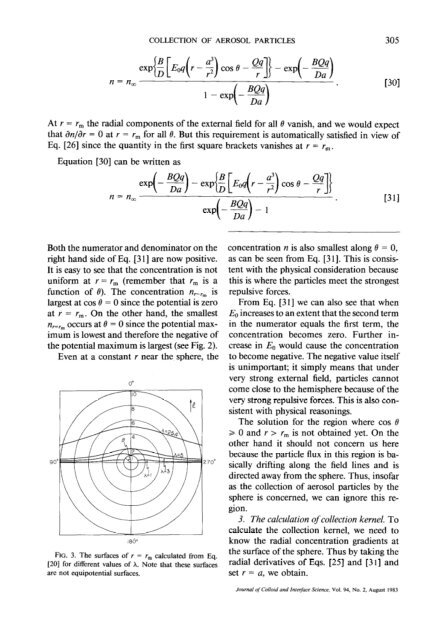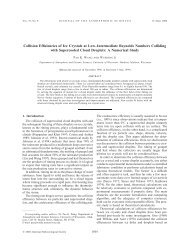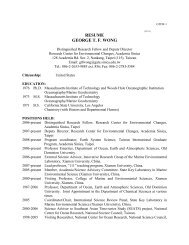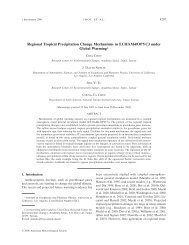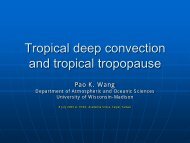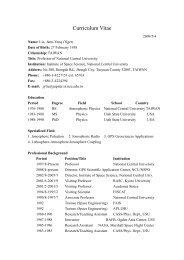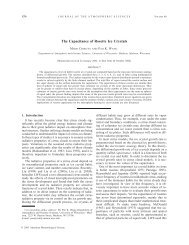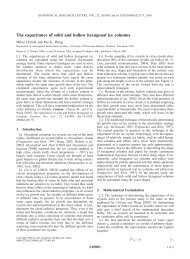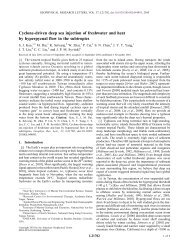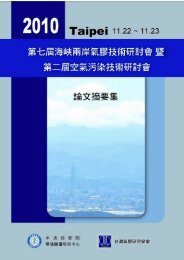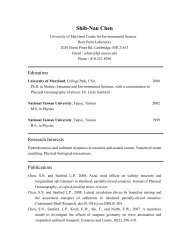Collection of Aerosol Particles by a Conducting Sphere in an ...
Collection of Aerosol Particles by a Conducting Sphere in an ...
Collection of Aerosol Particles by a Conducting Sphere in an ...
- No tags were found...
You also want an ePaper? Increase the reach of your titles
YUMPU automatically turns print PDFs into web optimized ePapers that Google loves.
COLLECTION OF AEROSOL PARTICLES 305n=n m [301At r = r, the radial components <strong>of</strong> the external field for all 8 v<strong>an</strong>ish, <strong>an</strong>d we would expectthat <strong>an</strong>@- = 0 at Y = r, for all 8. But this requirement is automatically satisfied <strong>in</strong> view <strong>of</strong>Eq. [26] s<strong>in</strong>ce the qu<strong>an</strong>tity <strong>in</strong> the first square brackets v<strong>an</strong>ishes at r = r,.Equation [30] c<strong>an</strong> be written asexp(-z)-exp{$[E,q(r-$)cos*-$11n = n, [311exp -BQ4\ - 1( Dal LBoth the numerator <strong>an</strong>d denom<strong>in</strong>ator on theright h<strong>an</strong>d side <strong>of</strong> Eq. [3 11 are now positive.It is easy to see that the concentration is notuniform at r = r, (remember that r,,, is afunction <strong>of</strong> 0). The concentration y1,, islargest at cos 0 = 0 s<strong>in</strong>ce the potential is zeroat r = r,. On the other h<strong>an</strong>d, the smallestn,=, occurs at 0 = 0 s<strong>in</strong>ce the potential maximumis lowest <strong>an</strong>d therefore the negative <strong>of</strong>the potential maximum is largest (see Fig. 2).Even at a const<strong>an</strong>t r near the sphere, the0”FIG. 3. The surfaces <strong>of</strong> r = r, calculated from Eq.[20] for different values <strong>of</strong> h. Note that these surfacesare not equipotential surfaces.concentration n is also smallest along 0 = 0,as c<strong>an</strong> be seen from Eq. [3 11. This is consistentwith the physical consideration becausethis is where the particles meet the strongestrepulsive forces.From Eq. [3 I] we c<strong>an</strong> also see that whenEO <strong>in</strong>creases to <strong>an</strong> extent that the second term<strong>in</strong> the numerator equals the first term, theconcentration becomes zero. Further <strong>in</strong>crease<strong>in</strong> EO would cause the concentrationto become negative. The negative value itselfis unimport<strong>an</strong>t; it simply me<strong>an</strong>s that undervery strong external field, particles c<strong>an</strong>notcome close to the hemisphere because <strong>of</strong> thevery strong repulsive forces. This is also consistentwith physical reason<strong>in</strong>gs.The solution for the region where cos f3> 0 <strong>an</strong>d r > r, is not obta<strong>in</strong>ed yet. On theother h<strong>an</strong>d it should not concern us herebecause the particle flux <strong>in</strong> this region is basicallydrift<strong>in</strong>g along the field l<strong>in</strong>es <strong>an</strong>d isdirected away from the sphere. Thus, <strong>in</strong>s<strong>of</strong>aras the collection <strong>of</strong> aerosol particles <strong>by</strong> thesphere is concerned, we c<strong>an</strong> ignore this region.3. The calculation <strong>of</strong> collection kernel. Tocalculate the collection kernel, we need toknow the radial concentration gradients atthe surface <strong>of</strong> the sphere. Thus <strong>by</strong> tak<strong>in</strong>g theradial derivatives <strong>of</strong> Eqs. [25] <strong>an</strong>d [31] <strong>an</strong>dset r = a, we obta<strong>in</strong>.Journal <strong>of</strong> Co/lord <strong>an</strong>d Interface Science, Vol. 94, No. 2, August 1983


